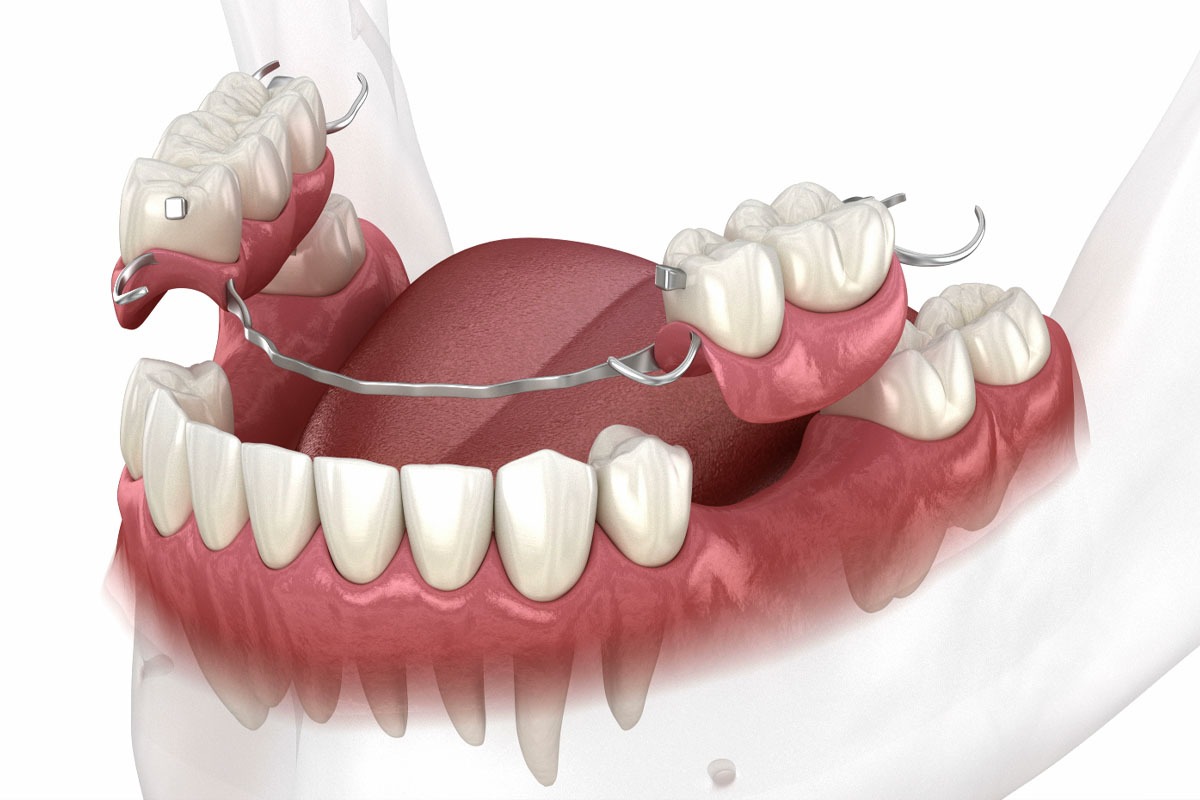A flipper tooth is one of the most common temporary solutions people choose when they lose a tooth. Many patients hear about it for the first time at the dentist’s office, often after facing tooth loss due to an accident, decay, or gum disease. While it can be a quick and affordable fix, it’s important to understand what a flipper is, how it works, and how it compares to a long-term option like a dental implant.
In this guide, we’ll walk through what a dental flipper is, the types of dental flippers, the flipper tooth cost, pros and cons, and a full comparison of flipper tooth vs. dental implant to help you make the right choice for your smile.
Table of Contents
ToggleWhat Is a Flipper Tooth?
A flipper tooth is a removable partial denture designed to fill in the gap left by a missing tooth. Think of it as a temporary tooth that “flips” in and out of place.
Made of acrylic material, a dental flipper usually includes a pink-colored base that looks like gum tissue, with one or more false teeth attached. It clips onto your existing teeth for support and can be worn during the day to restore your appearance and ability to eat certain foods.
Dentists often recommend flippers as a temporary solution while you wait for a more permanent treatment, such as a dental bridge, denture, or dental implant.
Types of Dental Flippers
There are different types of dental flippers, and your dentist will suggest the best option based on how many teeth you are missing and where the gap is located.
1. Single Tooth Flipper
It is the most common type. It replaces one missing tooth, often a front tooth that is visible when you smile.
2. Multiple Tooth Flipper
This version can hold two or more replacement teeth on the same acrylic base. It’s useful if you have several missing teeth in one area.
3. Temporary Partial Denture
Some flippers are designed to act like partial dentures for a short time, especially when patients are waiting for dental implant placement or healing after extraction.
Flipper Tooth Cost
One of the main reasons patients choose flippers is affordability. The flipper tooth cost can vary depending on where you live, the materials used, and your dentist’s expertise.
- On average, a single flipper dental appliance costs between $300 and $500.
- More complex flippers, such as those with multiple replacement teeth, may cost up to $1,000.
- Dental insurance may cover part of the cost, especially if the flipper is used as a temporary solution after tooth loss.
Compared to other options, flippers are one of the most budget-friendly ways to restore your smile, at least in the short term.
Advantages of a Flipper Tooth
Many patients find flippers to be helpful right after losing a tooth. Some key benefits include:
- Affordable option compared to implants or bridges.
- Quick to make, usually ready within a few days.
- Improves appearance by filling the gap immediately.
- Lightweight and easy to wear.
- Temporary flexibility while waiting for a permanent solution.
Disadvantages of a Flipper Tooth
While flippers are useful, they also have some drawbacks:
- Not as stable as dental implants or bridges.
- It can break easily because of the acrylic material.
- May feel bulky or uncomfortable in the mouth.
- Needs to be removed and cleaned daily.
- Does not prevent bone loss in the jaw, which can occur when teeth are missing.
Flipper Tooth vs. Dental Implant
When it comes to choosing between a flipper tooth vs. a dental implant, it’s important to compare both options side by side.
Feature | Flipper Tooth | Dental Implant |
Cost | $300 – $1,000 | $3,000 – $6,000 (per tooth) |
Durability | Short-term (months to a few years) | Long-term (20+ years) |
Comfort | May feel bulky, removable | Feels like a natural tooth, permanent |
Appearance | Improves smile but less natural | Very natural look |
Bone Health | Does not prevent bone loss | Preserves jawbone |
Maintenance | Must be removed and cleaned daily | Brush and floss like natural teeth |
Treatment Time | A few days to make | Several months (including healing time) |
If you need a fast and budget-friendly fix, a flipper dental appliance may be the right choice. However, if you’re looking for a permanent solution that supports long-term oral health, a dental implant is usually the better option.
Who Should Consider a Flipper Tooth?
A dental flipper is best suited for:
- Patients who have just lost a tooth and want a quick replacement.
- Those waiting for a dental implant or bridge.
- People are looking for an affordable short-term fix.
- Children or teenagers who are not yet old enough for implants.
Caring for Your Flipper Dental Appliance
To make your flipper last longer and keep your mouth healthy, follow these tips:
- Remove and clean daily with a soft toothbrush and mild soap.
- Avoid hot water, as it can warp the acrylic.
- Soak overnight in a denture solution to keep it fresh.
- Handle with care, since flippers can break if dropped.
- Visit your dentist regularly to check the fit and condition.
How Long Does a Flipper Tooth Last?
A flipper tooth is designed as a short-term solution, but its lifespan depends on how well you care for it and how often you wear it.
- On average, a flipper lasts 6 months to 2 years.
- Proper cleaning and storage can extend its durability.
- Because it’s made of acrylic, it is more fragile than permanent options and may need repairs or replacement over time.
Dentists often recommend using a flipper only until you are ready for a more permanent treatment, such as an implant, bridge, or denture.
Eating and Speaking with a Dental Flipper
A dental flipper allows you to eat and talk more comfortably, but there are some limits.
- You can eat most soft foods easily, but avoid hard, sticky, or chewy foods that could break or loosen the appliance.
- Some patients notice minor changes in speech at first, especially with certain words, but this usually improves with practice.
- Over time, most people adapt and use their flipper without problems.
Adjusting to a Flipper Dental Appliance
Wearing a flipper dental appliance for the first time can feel unusual. Here’s what to expect during the adjustment period:
- A feeling of bulkiness in your mouth for the first few days.
- Slight pressure or soreness as your gums adapt.
- Improvement in confidence as you get used to eating and smiling with it.
Most patients fully adjust within one to two weeks. If discomfort continues, your dentist may need to adjust the fit.
Do’s and Don’ts for Flipper Tooth Users
To keep your flipper tooth comfortable and long-lasting, here are some simple tips:
Do’s
- Clean daily with a soft toothbrush and mild soap.
- Soak overnight in denture cleaner to keep it fresh.
- Handle with care. Always place a towel on the sink in case you drop it.
- Visit your dentist regularly for fit adjustments.
Don’ts
- Don’t eat hard, crunchy, or sticky foods that can crack or loosen it.
- Don’t use toothpaste for cleaning it can scratch the acrylic.
- Please don’t leave your flipper dry; it may warp.
- Don’t try to repair or adjust it yourself; always see a dentist.
How Lincolnwood Family Dental Can Help
At Lincolnwood Family Dental, we understand that losing a tooth can affect more than just your smile; it can also impact your confidence, comfort, and daily life. That’s why our team offers both flipper teeth and dental implants, giving you options that fit your needs and goals.
When you choose our clinic, you can expect:
- Personalized guidance to help you decide between a short-term solution like a flipper and a long-term option like an implant.
- Affordable care with clear explanations of the flipper tooth cost and financing options for implants.
- Expert fitting and adjustments to make sure your flipper feels comfortable and natural.
- Advanced implant services for patients who want a permanent replacement that looks and functions like a real tooth.
- Ongoing support so you feel confident and informed throughout your treatment journey.
Whether you need a quick fix after tooth loss or a lasting solution for lifelong oral health, Lincolnwood Family Dental is here to help you smile again with comfort and confidence.
If you’re ready to explore your options or have questions about flipper teeth vs. dental implants, schedule a consultation with our team today and take the first step toward a healthier smile.
The Bottom Line
A flipper tooth can be a great short-term option after tooth loss, offering an affordable way to restore your smile. However, it is not a permanent solution. For long-term comfort, stability, and bone health, dental implants are the better choice.
If you’re deciding between a dental flipper and an implant, it’s best to talk to your dentist about your needs, budget, and long-term oral health goals.
Frequently Asked Questions - FAQs
What is a flipper tooth, and why is it used?
A flipper tooth is a temporary replacement for a missing tooth. It helps restore your smile, supports basic chewing and speaking, and is often used while waiting for a permanent solution like a dental implant or bridge.
How much does a flipper tooth cost on average?
The flipper tooth cost typically ranges from $300 to $500 for a single tooth. More complex versions that replace multiple teeth can cost up to $1,000. Insurance may cover part of the cost if it’s needed after an extraction.
Can you eat normally with a flipper tooth?
You can eat with a flipper tooth, but it’s best to avoid hard, sticky, or crunchy foods that may damage or dislodge it. Softer foods are easier to manage while wearing a flipper.
How long can you wear a flipper tooth before replacing it?
A flipper tooth is designed for short-term use. With proper care, it can last from 6 months to 2 years, depending on your oral health and whether you plan to get a permanent replacement.
What is the difference between a flipper tooth and a dental implant?
The main difference between a flipper tooth and vs. dental implant is that a flipper is removable and temporary, while an implant is permanent and functions like a natural tooth. Implants also protect the jawbone from bone loss, which flippers cannot do.









